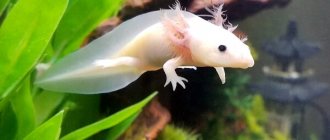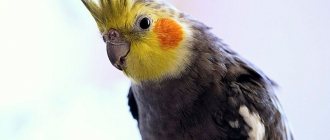The axolotl is a small amphibian belonging to the family Ambystomidae from the order Caudate. The animal has an amazing ability to regenerate, restoring not only the lost tail, limbs or external gills, but also partially damaged internal organs.
The ability to restore almost any type of cell and stable immunity have caused close attention from scientists. Currently, amphibians, along with rodents and rabbits, are the most popular laboratory animals for scientific and medical research. In addition, histological preparations from the liver of an amphibian are used to study animal cells: they are quite large in size, which makes it possible to clearly examine all the structural components even at low magnification. Cytology and histology courses at universities necessarily include laboratory classes, during which the structure of the cell is studied and pigment, secretory and fatty inclusions in the liver cells of the axolotl are determined.
Characteristics and description of the animal
Axolotls are nocturnal. After dark, they go out in search of prey, and during the day they prefer to hide in thickets of algae and other natural shelters, or rest at the bottom of the reservoir, slightly moving their tail and gills.
The structural features of Ambystoma larvae lie in the special shape of the gills: they are located not inside, but outside. This species of amphibian has two respiratory organs. In water, the axolotl uses gills, and on land it breathes with the help of lungs.
Looking at the axolotl, you might think that this is a cute, always smiling animal with a calm character. In fact, amphibians are distinguished by quite aggressive behavior and often engage in fights with representatives of their own species.
Who is an axolotl
The name does not belong to a separate species of animal, but to the neotenic form of the Mexican Ambystoma ( Ambystoma mexicanum ). Due to insufficient production of thyroxine in the thyroid gland, the amphibian can remain in the larval stage for a long time and not move to the next stage of development. Several other species of newts and salamanders from the order of caudate amphibians have the same feature.
What does it look like
The axolotl has a very unusual appearance, which combines the characteristics of fish and amphibians. This is a kind of fish with legs, the head of which is decorated with a crown of external gills, reminiscent of twigs with many processes.
The body of axolotls is covered with smooth skin, it is elongated, and in the back it is flattened laterally in the form of a fish tail. The animal has two pairs of legs, there are 5 fingers on the hind limbs, and 4 on the front limbs. The head is large with small shiny eyes and a large mouth.
Types of colors
Axolotls living in natural conditions have a marbled color: a brown or greenish-brown body is covered with many black and light brown spots. Tiger axolotls are almost completely black.
With the beginning of artificial breeding of the animal, a wide variety of colors were obtained. The most common aquarium amphibians are:
- albinos with a completely white body, red eyes and pink gills;
- golden dragons with red eyes and golden spots on the body;
- white with black eyes and pink or blue patterns on the back;
- gray with black eyes;
- marbled gray-blue color with many green and dark gray spots.
Kinds
Color depends on the species:
- pink with black eyes;
- pinkish-white with red eyes;
- golden with golden eyes;
- gray with black eyes;
- black axolotls;
- light color with spots.
The white axolotl with red eyes is an albino. Albino axolotls are less common than other species in nature, but are actively bred for the aquarium hobby. Salamanders with golden spots are highly valued: golden spots appear on the body, which give an unusual appearance to the cute animal.
How an axolotl turns into an ambistoma
Water dragons living in stable conditions can remain in the larval stage throughout their lives. A sharp drop in temperature, a decrease in humidity and a drop in water level can cause metamorphosis in the body of an amphibian. Over the course of several weeks, the Ambystoma larva changes its body shape and color and turns into a salamander.
The animal is fully adapted to live on land, but when it stays in water for a long time, its gills grow back.
When kept in captivity, the transition to the adult stage can be caused by injection of the hormone thyroxine. Artificially induced transformation of an axolotl often leads to its death.
Regeneration is the dream of humanity
Another unique feature of the pink axolotl is the ability to regrow missing body parts. Nature gave this skill to the larva so that it would not be so vulnerable. Having lost his gills or part of his tail, the smiling dinosaur grows them back in record time. It takes a little longer to grow a new paw. The main condition is that the wound does not get infected. This rarely happens in the clear waters of Mexican lakes. Ironically, aquarium axolotls are much more likely to suffer damage. Instead of quickly restoring the lost body part, they die from blood poisoning.
Reproduction
Axolotls reach sexual maturity at 9-11 months, without transitioning into adult form. During the mating season, males release spermatophotes, which descend to the ground. The females swim up to them and pull them inside with the cloaca. Fertilized axolotl eggs are attached to algae, stones, and driftwood. The ripening of eggs lasts 18-20 days. The fry that are born have no limbs. Paws grow back only after three months. The young feed on small insect larvae, fish eggs, and invertebrates.
Feeding
The axolotl is a nocturnal predator. The basis of its diet when kept in an aquarium should be protein food.
Suitable for these purposes:
- worms;
- cockroaches;
- crickets;
- mussels;
- shrimps;
- crustaceans;
- bloodworm;
- live fish (with caution to prevent contamination);
- dry food for predatory aquarium inhabitants.
Any meat from mammalian species is strictly prohibited. The axolotl's gastrointestinal system is designed in such a way that it is not able to digest such protein.
Under no circumstances should water dragons be overfed, but they should not starve either, they become aggressive.
When feeding the axolotl, you need to get him interested in the food, because if it doesn’t move, he may not notice it. Therefore, the water dragon is often fed by hand or using special tweezers.
In addition, the axolotl's eyes are designed in such a way that they can only look up; they cannot see what lies at the bottom.
With its jaws, this pet is able to grab even a large fish and, holding it, gradually swallows it whole. It will take the dragon several days to digest such prey. Therefore, adult individuals are usually fed to their fullest, but once every 2-3 days.
If you feed an axolotl every day, it will eat without stopping; this species is prone to overeating. But in fact, they are capable of fasting for almost a month.
What does it eat in nature?
The basis of the axolotl's diet is food of animal origin. They hunt fry and small fish, amphibians, and look for snails and crustaceans at the bottom. Axolotls have poor vision, so when searching for prey, they focus primarily on movement. The water dragon sucks up the caught victim, swallowing it whole, and then grinds it with its palate and small teeth for a long time. Due to their slow metabolism, animals can eat once every few days, and in the absence of food they can starve for longer periods of time.
Natural habitat
In the wild, the water dragon lives in the canal system of Mexico's Lake Xochimilco. It is located within the city of Mexico, at an altitude of about 2 thousand meters above sea level.
The second habitat of axolotls, Lake Chalco, has long since dried up.
Axolotls live underwater, and although they are classified as amphibians, no one has ever seen them on land.
Axolotls are also found in water bodies of the USA and Canada. It is in those areas that the amphibian ambystoma are most common.
Ambystoma larvae settle in deep pools where dense vegetation predominates. They love cool weather. Therefore, the temperature of the water where water dragons live does not exceed 13 oC
Important!
Now the axolotl is an endangered species of animal, its natural population is on the verge of extinction.
Care and maintenance at home
Axolotls are exotic aquarium animals. Despite the fact that their breeding and keeping in captivity began in the 19th century, amphibians are still considered exotic. This is due to certain difficulties in maintenance and care.
Before purchasing an amphibian and placing it in a home aquarium, it is necessary to create conditions that are as close as possible to the axolotl’s natural habitat.
The most important point is to maintain a comfortable water temperature in the aquarium. In nature, animals live in high mountain lakes with cool water. The optimal temperature for keeping amphibians is below 22 degrees. In warm water they begin to lack oxygen and are susceptible to various fungal diseases.
How to distinguish a female from a male
Sexual dimorphism in axolotls is expressed in the structural features of the cloaca. In females it is smooth, and in males it is convex. When keeping individuals of different sexes in the same aquarium, it is possible to obtain offspring. The reproduction mechanism starts naturally with seasonal temperature changes. There are also several ways to stimulate males and females for the beginning of the mating season. For this purpose, separate housing of amphibians is used, the water temperature changes, and daylight hours decrease or increase.
FROG
Dimensions and arrangement of the aquarium
The required container volume for keeping axolotls is calculated as follows:
- For a comfortable existence, a young amphibian needs up to 50 liters of water;
- an adult will need an 80-100 liter aquarium;
- when keeping two or more lizards, 50-80 liters are added to this volume for each individual.
The Mexican water dragon is picky about water temperature, its purity and oxygen levels. Due to this, additional equipment may be required to filter and cool the aquarium. It is better to use shells or pebbles as soil.
Lizards need places where they can hide during daylight hours. Hollow ceramic figurines, driftwood, and large stones are used to create shelters. All objects placed in the aquarium should not have sharp edges that could injure the axolotls. The number of objects is selected so that all individuals can hide separately from each other. Otherwise, there will be constant clashes between them with injuries.
The location for installing the aquarium should be selected taking into account the fact that amphibians do not tolerate bright light and noise well.
SNAIL
Who can you keep with?
Many novice aquarists add axolotls to fish, turtles, frogs and other aquarium inhabitants. How correct is this? Fish and amphibians have different requirements for temperature, water hardness and acidity parameters. In addition, fish often cause damage to the protruding gills of lizards. Axolotls, which are nocturnal, eat eggs, tadpoles, fry and small fish.
If, when purchasing amphibians, you plan to keep them in an aquarium with fish, then the only suitable option is veil tails. They are very slow, not aggressive and are large enough not to be eaten by an amphibian.
What can you feed an axolotl?
Any type of food for predatory fish is suitable for feeding. The aquarium axolotl happily eats the meat of crustaceans and mollusks, cut into pieces of worms, and fillets of marine fish. Poultry and animal meat should not be given, since the proteins contained in it are not digestible. The amount of food should be such that the lizard eats everything completely, otherwise, due to food residues remaining in the water, the water will quickly deteriorate.
Signs of the disease and treatment
Axolotls are resistant to many diseases, but improper care can cause the following diseases:
| Diagnosis | Causes | Signs | Treatment |
| Saprolegniosis | Irregular cleaning of the aquarium, large amounts of food debris | The skin and gills become covered with a white coating; if left untreated, the fungus destroys the gills | The aquarium is completely cleaned and the water is replaced, during treatment the water temperature is reduced to +10, the animal’s body is briefly immersed in salt water, the skin is treated with hydrogen peroxide, and Baktopur is added to the aquarium |
| Red paw syndrome | Contaminated food gets into the aquarium | The paws become covered with a rash, the gills become deformed and darken. | The aquarium is washed and disinfected, the lizard is given baths with antibiotics and herbal decoctions, Bactopur is added to the water |
| Hypoxia | Low oxygen content in water | The gills turn pale, the appetite worsens, the eyes become cloudy | Amphibians are given injections of Catosal and Dexamethasone, and equipment is installed to saturate the water with oxygen. |
CHAMELEON
Compatibility
Compatibility is an important issue in keeping any aquarium inhabitants, a question about which many copies have been broken, and axolotls are no exception. However, most owners keep them separately and for the following reasons.
Firstly , the external gills characteristic of axolotls make them vulnerable to attack by fish. Even calm and slow fish species cannot resist the temptation to try to bite them, and as a result, pitiful scraps remain of the luxurious shoots.
Secondly , axolotls are active at night and sleeping fish, in turn, become easy targets for them. It is almost impossible to find a middle ground between size (so that the fish does not get eaten) and aggressiveness (so that the axolotl itself does not suffer).
But there is an exception to every rule, which allows you to keep axolotls with fish. And this exception is goldfish. They are very slow, and if they are well fed, most will not even try to chase the axolotl.
Only a few will try, they will get a painful pinch and will stay away. Plus, keeping goldfish also requires low water temperatures, making them an ideal choice.
And yet, the safest way is to keep the axolotl separately, and one individual per aquarium. The fact is that they pose a danger to each other, young and small axolotls suffer from old and large ones and can lose limbs or even be eaten.
Overpopulation leads to the same consequences, when a larger individual kills a smaller one. It is very important to keep only individuals of equal size in a spacious aquarium.
Interesting Facts
- As a result of crossing axolotls with different genes, it was possible to obtain a species on the body of which, under the influence of a fluorescent lamp, luminous spots and patterns appear.
- The Aztecs used water dragons to make medicinal potions.
- In their natural habitat, representatives of different species of amphibians do not interbreed, but when kept in captivity they are capable of producing offspring.
- Axolotls are listed in the International Red Book as an endangered species.
Origin story
Lakes Chalco and Xochimilco, which are located in Mexico, are considered to be the homeland of axolotls.
They were found there during the reign of the Aztecs.
This is interesting
It was the Aztecs who came up with the name "axolotl"
Translated from their language it meant “river monster.” The ancient Indians ate axolotls, considering them a delicacy. But even now modern Mexicans are not averse to eating these larvae.
But in Europe, axolotls appeared in the second half of the 19th century. Most likely they were brought by one of the fishing vessels.
In 1985, the first individuals were bred in captivity in the History Museum in Paris. And soon their active spread on the European continent began.
Various types of ambisto larvae have been bred, including the golden axolotl, harlequin, albino axolotl, and white axolotl.
Moreover, the latter two are often confused with each other due to identical skin color. Only albinos have white skin with a pink tint, while white axolotls have a matte white body. Albinos have red eyes, light gills with bright scarlet hairs. White axolotls have black eyes and dark gills with pink hairs.
In the XIX - early XX centuries. Ambistoma larvae, which were created in the laboratory, were used for research and experiments, but now they are used only for decorative purposes, released into home aquariums.
Key Features
The predator axolotl is motionless most of the time. He, as he does for hunters, waits for his prey: a gaping snail or a worm.
It takes 2-3 days for him to digest food.
The ability to renew himself in this way is a vital necessity for him.
Cute kids have a bad habit of biting off each other's paws. So the larvae learned to regrow lost limbs and organs.
The whole process follows the same scheme:
- the end of the stump is rounded:
- the damaged limb takes on a conical shape;
- the foot is constantly growing, a flipper is formed;
- finger rudiments are formed.
Scientists are studying this phenomenon. Perhaps, over time, the axolotl will teach people how to restore their arms and legs.
And today he often has to sacrifice himself for the sake of science. Most populations live in laboratories.
Extraordinary water monster
From the Aztec language, the word axolotl is translated as “water dog” or “water monster.” There is nothing scary about our hero’s appearance - this salamander looks more like a small funny dragon. The coloring of cute monsters can vary from dark gray to a very light whitish shade. Albinos bred in captivity are white. There are also brown and brown color options; they are excellent for camouflage and make the water dragon almost invisible.
From the editor: WORLD OF AQUARIUM FISH
The axolotl is easily identified by the funny and slightly bushy appendages (three on each side) on its head. These are actually its external gills. Dragons also have small eyes and a very wide mouth, which constantly gives them a laughing, smiling appearance. They also have small teeth.
Unlike most of the inhabitants of the aquarium, nature gave the baby monsters short legs with toes (4 on the front, 5 on the back). The tail of the larvae is long and wide, helping to swim.
The usual size of an axolotl is 20-25 cm, but some specimens can reach up to 35-45 cm. Weight - 300 g. Males are usually slightly larger than females - mainly due to the length of the tail. In an aquarium, dragonets usually live up to 10 years; with very good care, they can reach a very respectable age - 15-20 years. One of the most unusual abilities of these creatures is the ability to regenerate. They can regrow not only gills or a tail, but also entire limbs.
Who do these underwater inhabitants get along with?
Ambistoma larvae and aquarium fish cannot coexist in the same tank: axolotls will actively hunt small neighbors, and suffer from large ones - predators will attack them or tear their appendages. It will also not be possible to have a peaceful neighborhood with turtles and other aquatic inhabitants; the main reasons for this are incompatible nutrition and the likelihood of mutual aggression.
In addition, not all creatures can live in such a cool aquatic environment, and some representatives have common diseases. The only possible companions for axolotls are goldfish; they are too large to become food for newts and prefer to live in cool water.











